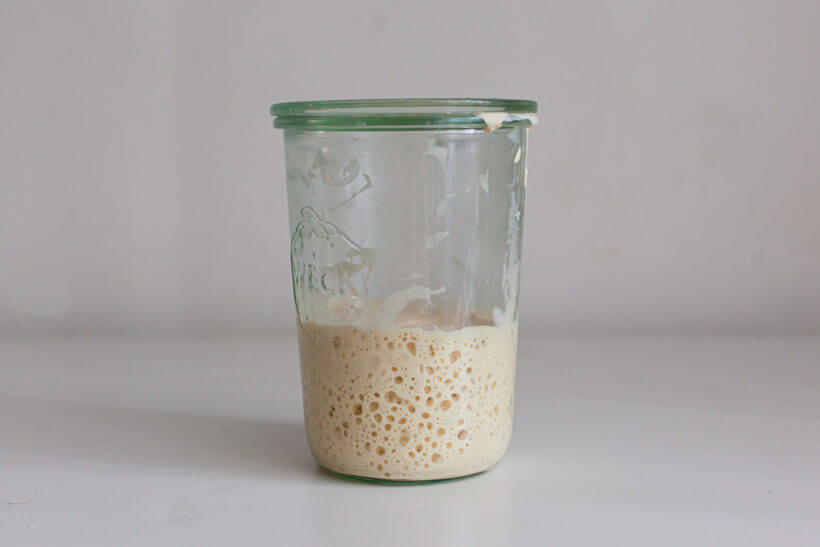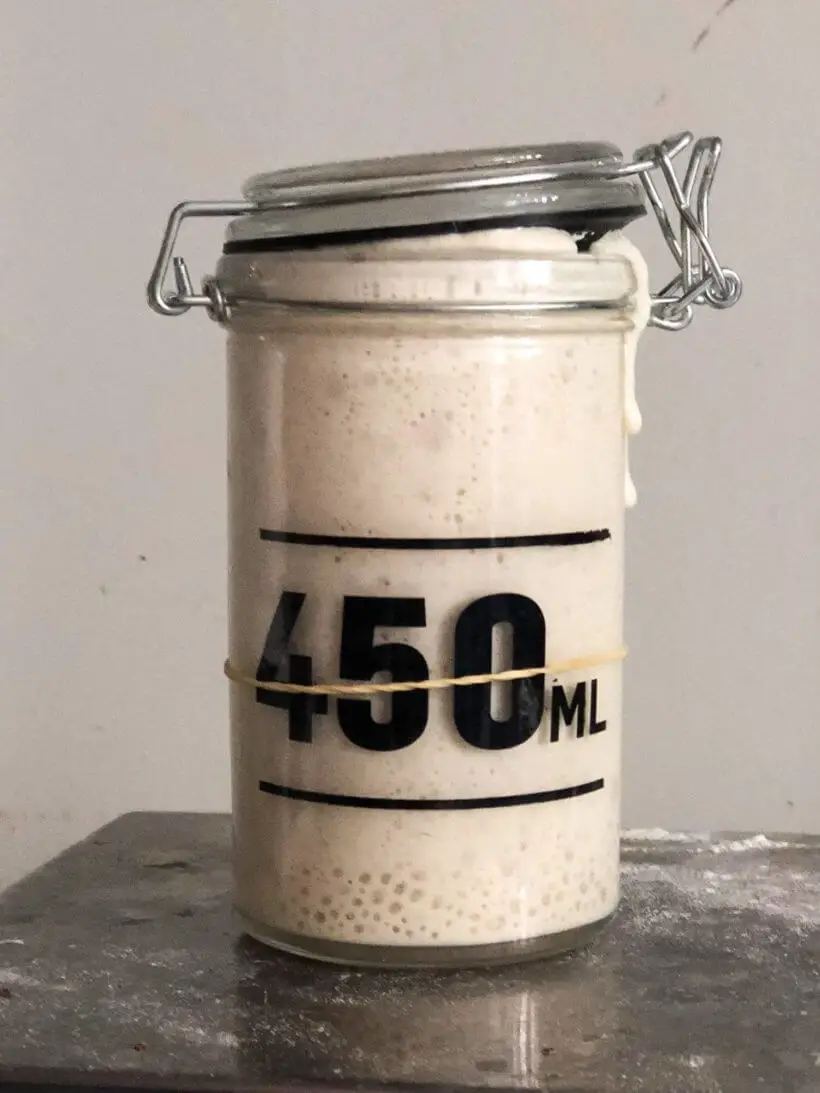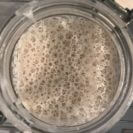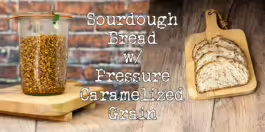If you are a fan of fantastic bread and baked goods, having a sourdough starter is a great tool in your baking arsenal; learn how easy it is to make your own. Just follow this sourdough starter recipe.
A sourdough starter is not difficult to make. All you need is time and a little bit of consistency. It’s the baking world’s answer to a green thumb.
Set off a specific time of day where you check and feed your sourdough starter. It does not matter when you do it, as long as it fits your daily schedule. It’s just important that you don’t forget it.
Got questions?
I’ve collected a list of frequently asked questions when you are building your sourdough starter. Read them all here.
Ode to my starter
Starter, oh, starter,
how I love thee.
Each time I feed you,
you grow by three.
You make the best bread,
with salt, water and flour
The tastiest loaves,
which, with glee, I devour
How do I keep it alive?
When your sourdough starter is ready, you need to keep it alive. If you are baking often I recommend that you keep it outside the fridge, so it is always ready to be baked. Keep feeding it as you’ve done it so far. Once a day.

If it seems less active or your kitchen is cold, maybe you will want to feed it every day.
If you are only baking once a week, you can keep it in the fridge during the week. If you want to bake on Saturday, you can “wake it up” on Friday morning, by taking it out and feeding it. Leave it on the counter. Feed it again in the evening and it should be ready for baking on Saturday morning.
So what? How do I use this sourdough starter recipe?
When your sourdough starter is active you can start baking with it. I’ve made a guide and recipe which is a fantastic place to start when you want to bake sourdough bread. So have a look at that!

It’s that easy. Just follow this sourdough starter recipe. Just get started. If you have any problems, you can just contact me.
Please share on social media
If you find this recipe useful, please help me and share it with your friends and followers. That would make me very happy.

Sourdough starter
Equipment
Ingredients
Instructions
- Start by putting 100 grams of rye flour and 150 grams of water in a glass container.
- Mix thoroughly so all the flour is hydrated.
- Put somewhere warm the next day (in a window in the sun or near a heater)
- Then follow the routine beneath until you have an active sourdough starter. You know it is active when it grows to at least double size over four to eight hours after the feeding.
Daily feedings
- Mix the sourdough starter
- Measure out 50 grams of sourdough starter in a fresh, clean glass container
- The leftover sourdough starter should be thrown out; at this point, it may contain bacteria that you don't want to eat.
- Add 100 grams of bread flour and 100 grams of water and mix thoroughly. Close the container. You can seal it if you want. Store somewhere warm (about 25°C/77°F)
- Repeat every day until your sourdough starter is bubbly and grows predictably. Normally it takes six to seven days
Video
Noter
- Every day when you are about to feed the starter, you might see a brownish liquid on the top of it. Just stir it back in.
- The starter should smell sour, it doesn’t mean it has gone bad.
- Any mold or mildew on top of the starter means it has gone bad. There is no way to save it.
Frequently asked questions (FAQ)
The reason you need to start the sourdough starter with rye flour is that there is more “food” for the yeast to eat. You can substitute with whole-wheat flour or bread flour if you don’t have rye. It may take longer for your starter to get active though.
It is very common that the starter will seem dead after a couple of days. Don’t get discouraged. Just keep the schedule. Feed every day.
An incredibly important factor in starting a sourdough starter is temperature. If your kitchen is around 20°C/68°F it will slow down the process significantly.
The starter works best between 25°C/77°F to 28°C/82°F. So put it somewhere warm. On top of the fridge or in a window with sunlight are good choices. If you have an oven where you can turn on the light without turning on the oven, that could be an option too.
Yes, it won’t hinder the growth as long as you open the glass every day (which if you follow the recipe you will do).
My starter was made with the glass jar sealed, but if it worries you, put the lid on top without sealing.
No, you have to constantly feed it to get it started. You can start putting it into the fridge after it grows every time you feed it. That should be after the “dead period” mentioned above.











Pingback: Sourdough bread recipe for beginners - it is very easy - Foodgeek
Pingback: Broa de Milho recipe - Portuguese corn bread - Foodgeek
Pingback: Worlds easiest sourdough bread - make awesome bread - Foodgeek
Pingback: Danish rye bread recipe - The classic dark rye bread - Foodgeek
Pingback: Sourdough bread oven spring - learn the secrets - Foodgeek
Pingback: Tiger Bread Rolls Recipe - fluffy inside, crunchy on the outside - Foodgeek
Pingback: Sourdough banana bread recipe - use your mushy bananas - Foodgeek
Pingback: Chocolate Sourdough Bread recipe - A bread for the ages - Foodgeek
Pingback: Sourdough Starter Maintenance - keep your starter healthy - Foodgeek
Pingback: Sourdough naan bread recipe - great with any curry - Foodgeek
Pingback: Gingerbread hearts recipe - delicious Danish fermented treats - Foodgeek
Pingback: High hydration sourdough bread recipe with tangzhong -Foodgeek
Pingback: Sourdough Focaccia recipe - a perfect bread for dinner - Foodgeek
Good day ,everytime I remove the 50 g of starter to add new flour and water should I do with the starter from the previous day?
You should take 50 grams of starter for the previous day and add 100 grams of flour and 100 grams of water 🙂
Thank you for sharing. I have started my starter yesterday.
Best of luck 🙂
Can I change the type of flour when I am feeding? Also what happens if I add more water than the 100gm? I accidentally added more water and today is day 5 and not seeing much activity.
Greetings from Brazil. Is it normal to get it to double in size at the very first 24 hours? I’ve started to make my starter yesterday afternoon and when it was late in the morning today, it was already doubled in volume, so I took 50 grams and fed it again (100/100g). When it was about the time I started it on yesterday it was overflowing the glass jar! so it tripled in volume! I’ve used regular white flour (as this is all we can find in Brazil, there is no strong or bread flour over here). So it took about 5 hours to double in volume. Is it right? I know that there are some flours in Brazil that would come already mixed with baking powder, but that would not be the case as I always make sure to pick the right one (no baking powder). Any guesses?
It’s normal for it to grow in the beginning. This is from bacteria, not yeast.
Usually around the 4th or 5th day it may seem dead. That’s a good sign. After that it should start to grow predictably and you can start to bake with it.
Pingback: Sourdough olive bread recipe - Meddeterranean inspired bread - Foodgeek
Hi Sune. Sorry if this is silly question but every time you feed the started, you are to remove a portion of the starter and put it in a new container and “feed” the stuff in the new container…and you do this for multiple days… what do you do with all those half filled containers of starter left behind.. can we throw it all together? Thanks
When you are making a starter you should throw it out. Once it starts going predictably after a feeding, you can use the leftover starter for discard recipes 🙂
If the ingredients are:
Bread flour,
Wholegrain rye flour
and
Water.
Then where does the yeast come from..?
It’s on the flour, in the air, on your hands. You know, love is all around us 😉
Hi, when you say add bread flour, do you mean just white or can it be a combo of white and whole-wheat?
Hi Sune, Great recipe for the calculator which I have been unable to download, but I would like a file copy please. I have been making SD for a couple of years, my favourite adding seeds as it, combined with SD is better for Type 2 diabetics. Tried your method from some of your videos, but not this one and used the lift and fold method. The result is the best ‘holey’ crumb so far. Didn’t bake quite long enough as domestic fan ovens NEFF don’t go to commercial heats and the fan means I have to block the vents to retain some of the steam as I bake on a pizza stone rather than Dutch oven.
Looking forward to a working calculator when you can find the time.
Regards
Peter
The calculator is only available online.
For more holes in your crumb, you should first have a super active starter, and then you should handle the dough very delicately 🙂
Hi – have you done ‘geek’ experiments on autolysing – periods of time, with and without salt, with and without the starter?
I haven’t tried different lengths of autolyse, but since the function is to mainly kickstart gluten development, you can always add time later in the process if you didn’t get the results you wanted.
I did do a test with without and with salt: https://youtu.be/Z0o-tkaDqps
I’ve started baking with everything mixed in. I should do an experiment with it 🙂
Hi Sune,
I was wondering if it was possible to speed up the process of making a new starter by feeding it more often as it establishes itself. For instance, would it be faster to feed it 3-4 times the first 2 days, 2-3 times the next two days, then finally once a day, as opposed to only feeding it once a day? Have you ever done an experiment like that?
Tasty regards!
Carey
I’ve haven’t done an experiment, but before some yeast has established itself in the starter I think you are just diluting it, stopping the process 🙂
Hi Sune,
My starter turned out exactly the way you described it. Now I would like to keep a portion in the fridge and feed it once a week so that I could revive it as needed. What amounts of flour and water should I feed the starter weekly?
Hey! Thanks for the great videos and instructions really helped in my sour dough journey. I was wondering if its possible to scale down the amount of starter recipe, instead of using 100g, can we use 10g/20g instead ?
When feeding which flour is best? when I feed with bread flour (100% whole wheat) it seems to take longer to double than feeding with all purpose flour.
Feed whatever flour makes your starter the most active 🙂
Hello,
How does increasing or decreasing the amount of starter used in a recipe affect the final loaf of bread?
It depends on how much you use. In the range of 5% to 30% it doesn’t, but above, probably. I am planning to test this 🙂
There is no yeast on the list of ingredients?
Hi Sune, what are you doing with rest of starter, which is not feeded for this day? If I don’t want to trash it, I would have at least 18 jars of starter after 6 days 😀 I think 18 jars at least 18 breads is too much to handle to eat it for less than half year. :o)
Pingback: Lockdown sourdough bread – Inconsequential
Hello! I’m a home baker i bake once every 2 weeks or so, i’m wondering will it still work if i reduce the portion of the starter ratio will it still work or do i have to keep to the 100g, seems like alot of flour to use.
Love your videos and experiments by the way 🙂 wish I’ve found your site earlier when i started on my sourdough journey. my first attempt turned out to be a disaster.
Also might i suggest for an updated version of the sour dough video consolidation of what you have learned over the past year seems the current videos are different from the first sour dough video you made.
Hi there. Can I feed on day 2 with rye flour/whole wheat flour or does it have to be bread flour?
Pingback: Simple artisan sourdough bread recipe - How to get started - Foodgeek
Hi Sune, I have really enjoyed your excellent experiments and learned a lot. Do you tune your starter to the mix of different flours in your current bread recipe, or always just use a starter fed with white bread flour?
Great recipes. I’ve made wonderful bread but not very sour. Suggestions?
Thanks 🙂
The easiest suggestion is to use whole grain rye instead of whole grain wheat 🙂
Otherwise let the levain go longer and use it when you feel it’s sour enough 🙂
should I begin starter with rye flour and then feed only with wheat flour? or can I continue to feed with rye? do you have a rye sourdough recipe? thank you
Hi, I have about 300 ml (1 cup) of starter which is a good and manageable size for me. What I would like to do for the upcoming holidays is to make many sourdough items. What is the process double, triple or quadruple the size of my starter? Is is enough to take my 300 ml (or a lesser amount) and add the same ratios of water and flour and let it sit overnight on the counter (assume 70F/21C)? Or, because of the volume, I should let it sit longer? Basically, is there a different process for increasing the starter amount? Thanks.
Pingback: Blueberry Lemon Sourdough Bread Recipe - it's wonderful - Foodgeek
Hello Sune, your videos on Youtube are great. I’ve been watching for a long time and am now finally ready to start my sourdough adventure 😊
I have a Panasonic Bread Maker model SD-ZB2512 which also has programs for sourdough bread. So I inted to experiment with that and with the oven. It has a “proofer” program to help produce the starter, so maybe you can add this info to your blog. Maybe it’s helpful for some people.
Maybe you can make geeky experiments with this bread maker (or another one) and post videos about this too 🙂
All the best to you in this new year, thank you for your very interesting videos.
Greetings. To start with sourdough stater I have taken 50gm whole wheat flour and 100gm of water and maintaining same pattern. today is the sixth day. Does my starter gets affected with more hydration? How can I calculate with preferment formula of yours. Thank you
My starter is 16 days old and I used it for the first time yesterday and the dough rose nicely. I’ll bake it today. To help my starter get as strong as possible, would it be better to keep it at room temperature, feeding it “peak-to-peak” for a couple more weeks? Once it’s really strong I’ll keep it in the refrigerator for convenience, but should I delay refrigerating it for awhile? How long? Thank you!
Ha, I live in tropical Asia. I made my starter with 150g bread flour and about 120g water (the video shows 100g flour and 150g water and 150g flour and 100g water so I just added water until 150g of flour was hydrated). After 24 hours it had more than doubled in size and was bubbling i.e. before the first feed. (Everything used was UV sterilized and reverse osmosis sterilized water was used.) It’s quite amazing!
Awesome. Starters thrive in warm climates 🙂
Pingback: Artisan Sourdough Bread - An easy recipe for crispy bread - Foodgeek
Hello Sune.
My name is Bart from Poland.
I have couple of questions about starter recipe. Especially no. 3 in daily feeding
Why I should throw away the rest of the sourdough? Why can I use it to make two portions of sourdough?
Or maybe I could add bread flour each day to the same jar with sourdough and mix everything together (like most does)?
What kind of bacteria do you mean?
If they are any bacteria and I mix them with the sourdough starter (before measure 50 grams) – so I will add theses bacteria to new portion of our sourdough starter too. Am I wrong?
I will be grateful for your help with it.
Many Thanks
Bart
Can your Danish Rye Bread sourdough recipe be a base for a boiled dough bread?
Hey Suve. We are a little family, just 2 of us. So I bake bread only twice per month. Can I keep the sourdough in the fridge for 2 weeks? Also, should I still feed it every day? Many thanks.
You can keep it in the fridge. Take it out about 8 hours before you bake it 1:2:2 to get it started 🙂
Hello! I am wondering if the temperature of the water matters? If so, what temperature do you recommend? Thank you
It does matter a bit because warmer water will speed up fermentation, but I usually don’t worry about it, and it’s fine 🙂
Pingback: Sourdough Chocolate Chip Cookies Recipe - Foodgeek
Pingback: Make Bread with Apple Sourdough Starter | An excellent fall bread | Foodgeek
I was given some starter from a friend who has been using it for years. I have fed it and kept it on the counter top near an undercover fridge vent. It seems to be sulking, as nothinghas happened in 3 weeks. There was some bicuit coloured liquid on top I stirred it in with moreflour. Still nothing. What can i do?
Day three…my starter is rising some but its very stiff as in not pourable like it shows in your video. Very gluteny if you will. Following the recipe as written. Is this ok? I’ve been covering the jar with several layers of cheesecloth, would this make a difference?
That’s fine. You are probably just using bread flour. I normally use all-purpose for my starter, since it works as well 🙂